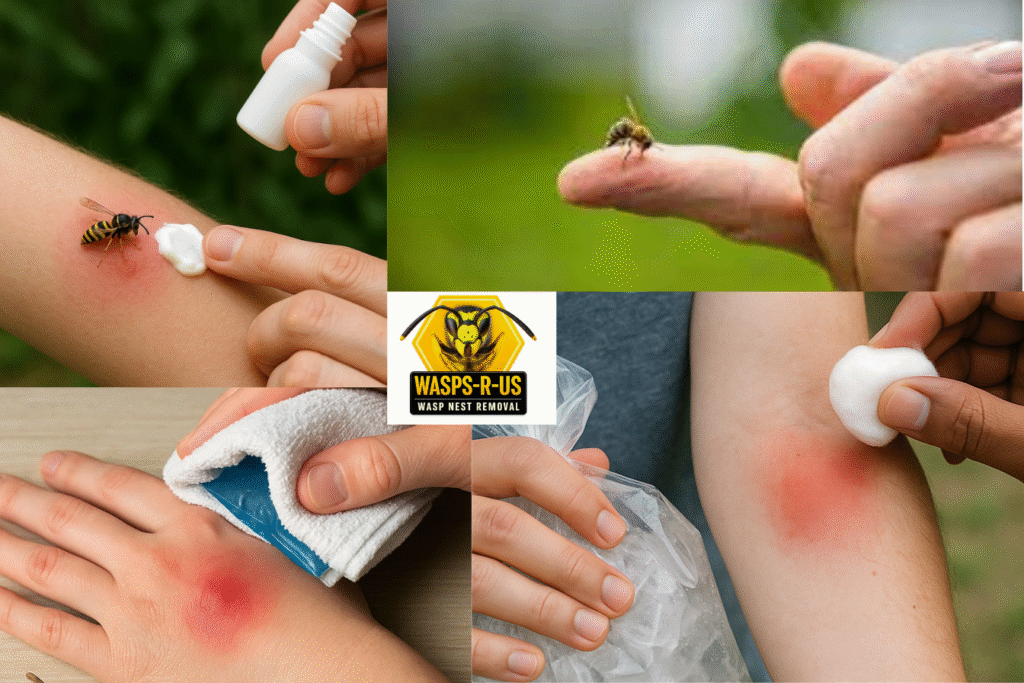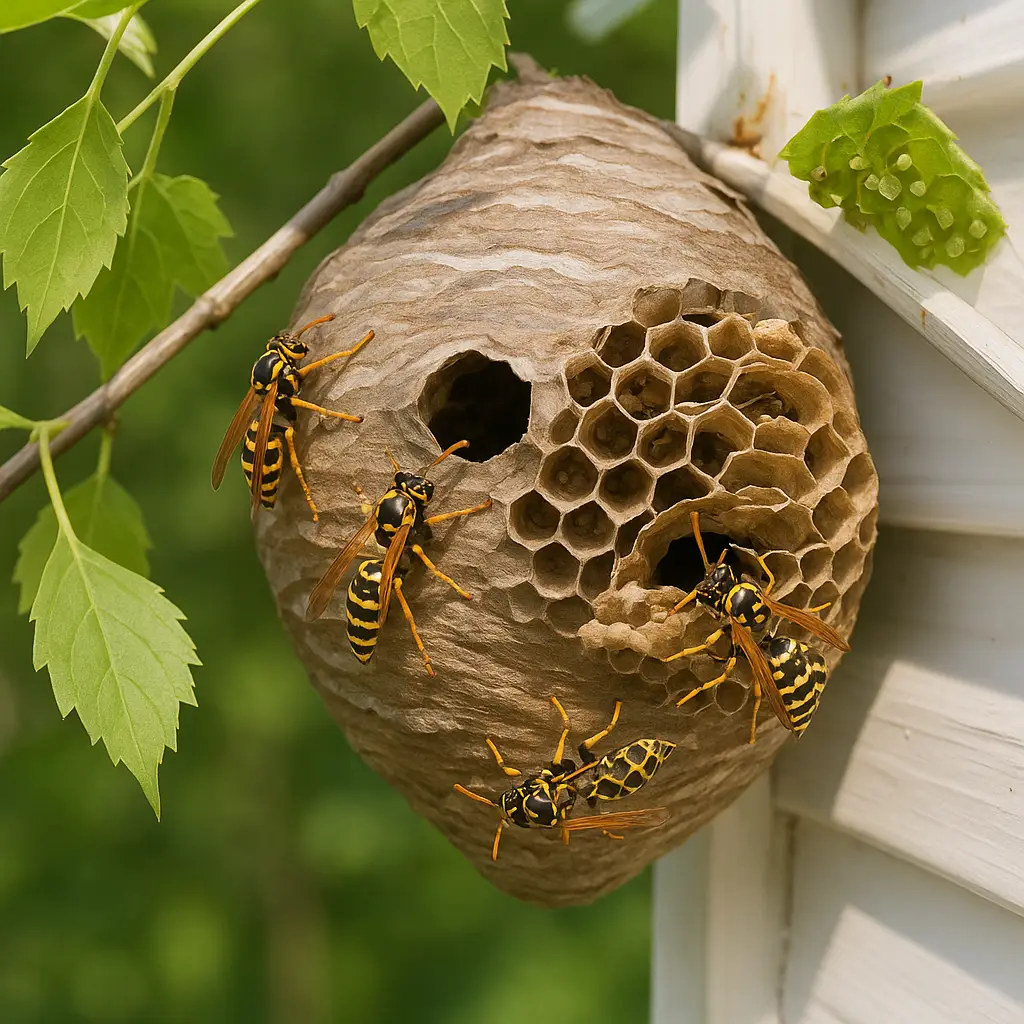What Happens When a Wasp Stings You
Wasp stings are a painful encounter and, for some people, a serious health risk. When a wasp stings, it injects venom into the skin. This venom causes a burning pain, swelling and redness. Unlike bees, wasps can sting multiple times and do not usually lose their stinger. That means they can be more aggressive and cause repeated stings in a short amount of time.
At Wasps-R-Us, we meet people all the time who ask about wasp sting treatment. While many stings are minor, some can cause serious reactions that need urgent care. Knowing what to do often makes all the difference in healing quickly and safely.
Recognising the Symptoms Early
The reaction to a wasp sting depends on how sensitive our body is to the venom. Most people will feel a sharp, stinging pain immediately after the sting. The area then becomes red, swollen, and itchy. This type of reaction, though very uncomfortable, is usually harmless and clears up within a few hours to a couple of days.
Some people, especially those allergic to wasp venom, might experience more serious symptoms. These include:
- Swelling that spreads beyond the sting site
- Sudden appearance of hives all over the body
- Trouble breathing or wheezing
- Dizziness or fainting
- Swelling around the mouth, lips, or throat
These are strong signs of a serious allergic reaction called anaphylaxis and need immediate medical help.
Spotting Anaphylaxis Symptoms in Time
Anaphylaxis can develop quickly after a wasp sting, sometimes within minutes. As it progresses, it can become life-threatening. Watch out for these anaphylaxis symptoms:
- A tight feeling in the chest or throat
- Trouble swallowing
- Slurred speech or confusion
- Vomiting or stomach cramps after the sting
If any of these signs appear, don’t wait. Inject epinephrine if available and call emergency services without delay. For people who know they have allergies, always carry an epinephrine auto-injector and make sure those around you know how to use it.
In emergencies, keeping calm, loosening tight clothing, and lying the person down flat with raised legs can help until help arrives.
First Response and Wasp Sting Treatment Basics
If the sting turns out to be mild and not allergic, home treatment can be very effective and is usually all that’s needed. Here’s what to do right away:
Immediate Actions
- Although it’s rare for a wasp to leave its stinger behind, check the area. If you do spot a stinger, use a blunt-edged item like a bank card to gently scrape it off. Don’t use tweezers or your fingers to pinch, as this can push more venom into the skin.
- Thoroughly wash the affected area with soap and water to clean the skin and stop bacteria from causing infection.
Soothe and Reduce Pain
- Apply a cold compress or an ice pack wrapped in a clean cloth. Hold it against the sting for 10 minutes, then remove it for 10 minutes, and repeat. This helps bring down swelling and ease the discomfort.
- If the sting is on an arm or leg, try to keep it raised. This helps with circulation and reduces puffiness.
What to Avoid
- Take off jewellery, tight-fitting clothes, or watches that might become tight if swelling sets in.
- Do not apply heat or hot water to the sting area.
- Avoid home remedies like mud, toothpaste, or vinegar directly on the skin. These can irritate or lead to infection.
Best Medications and Remedies for Wasp Sting Treatment
If symptoms are still bothering you after cleaning the area and using a cold compress, there are over-the-counter options that can help:
- Oral antihistamines such as loratadine or cetirizine can ease itching and swelling.
- Creams containing hydrocortisone or calamine lotion soothe the skin and reduce redness.
- Painkillers like ibuprofen or paracetamol can be used if the pain continues.
This kind of wasp sting treatment works best in mild-to-moderate cases, especially when there’s no allergy involved. If irritation, swelling, or pain lasts more than 3 days, be sure to speak to a doctor.
When Wasp Stings Become Serious
While most stings ease with time and care, some circumstances require a trip to the hospital even for people without allergies.
Seek urgent medical attention if:
- You are stung inside the mouth, throat or near the eyes.
- The swelling becomes hard and hot to the touch, showing signs of infection.
- There’s pus or the wound seems to be worsening instead of getting better after 48 to 72 hours.
- You develop a fever or body chills after being stung.
Even if the sting itself is small, a sensitive location or slow-healing response could pose a problem. If you’re unsure, it’s always better to be safe and get help.

Avoiding Stings in the First Place
We know from years of helping customers at Wasps-R-Us that the best way to deal with a wasp sting is to avoid getting one altogether.
Take these steps to help prevent run-ins with wasps:
- Keep food and drink covered when eating outdoors. Wasps love sweet and protein-filled scents.
- Don’t swat at wasps. Sudden movements may make them act aggressively.
- Wear shoes outside, especially in grassy areas.
- Avoid wearing heavily scented perfumes or lotions that could attract them.
- Keep your bins shut and clean outdoor eating spaces quickly after use.
If you notice a wasp nest around your home, it’s always safer to have it handled by trained professionals. Wasps can become very territorial near their nests, which sharply increases your chance of being stung. Our experienced team at Wasps-R-Us deal with wasp nest removal carefully and safely for homes and businesses.
When to Take Action Against Wasps
The time to act against wasps is as soon as you spot ongoing activity near your home or garden. Don’t wait for a sting to start thinking about prevention. If you or someone in your family is allergic, the risk is far greater. Often, nests are hidden in walls, lofts, sheds or underground, so you may not realise the danger until someone gets too close.
Trying to remove a wasp nest without the right gear or knowledge is dangerous. Our crew at Wasps-R-Us has the tools and experience to solve the problem safely. From first signs of wasps to full-blown infestation, we’re ready to step in so your family can enjoy your home and garden again.
Dealing with Recurring Stings and Anaphylaxis Symptoms
People with a known allergy to wasp venom should speak with their GP about getting a referral to an allergy specialist. Long-term treatment, including allergy injections (immunotherapy), is sometimes required. These help reduce reaction risks over time.
If you’ve ever shown anaphylaxis symptoms from a sting, you’ll need an emergency plan, which includes:
- Regularly checking the expiry dates on prescribed epinephrine injectors
- Telling family and close friends about your allergy
- Learning and practising how to give an epinephrine injection correctly
- Wearing a medical alert bracelet stating your allergy
It’s wise to prepare a travel kit with all the items you’ll need in case of an emergency, including any medicine, especially in the summer or during outdoor activities.
Dealing with Wasp Stings and When to Call the Experts
Wasp stings are never pleasant, but with quick thinking and the right wasp sting treatment, most can be managed safely at home. Knowing how to tell the difference between a mild response and more dangerous anaphylaxis symptoms keeps you and your loved ones safer. Keeping a cool head and using the correct first aid steps can ease the pain and reduce swelling quickly. For those with allergies, being prepared and knowing when to act is key.
If you’re regularly bothered by wasps or find a nest nearby, don’t leave it to chance. Reach out to the team at Wasps-R-Us for safe and thorough wasp nest removal. Let our professionals secure your space before the problem grows.



 Wasp Sting Treatment
Wasp Sting Treatment